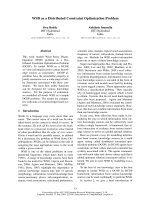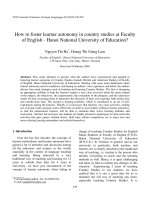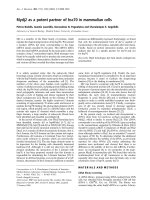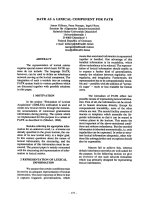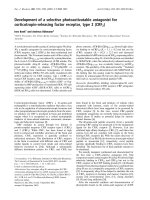Báo cáo " Self-regulated strategy development as a means to foster learner autonomy in a writing course " pdf
Bạn đang xem bản rút gọn của tài liệu. Xem và tải ngay bản đầy đủ của tài liệu tại đây (162.84 KB, 8 trang )
VNU Journal of Science, Foreign Languages 24 (2008) 246-253
246
Self-regulated strategy development as a means
to foster learner autonomy in a writing course
Nguyen Minh Hue
*
Department of English - American Language and Culture, College of Foreign Languages,
Vietnam National University, Hanoi, Pham Van Dong Street, Cau Giay, Hanoi, Vietnam
Received 08 May 2008
Abstract. This paper aims to propose a possible solution to a real-world curriculum problem of
how to foster learner autonomy in an English academic writing class at College of Foreign
Languages-Vietnam National University where a generally low level of learner autonomy is
perceived. It begins by defining relevant terms and representing the problem. Thence, the rationale
for the proposed solution and a plan for implementing it are discussed. The final section suggests a
plan for evaluating the effectiveness of the problem-solving task.
1. Introduction
*
The importance of learner autonomy in
language learning has been well established
in the literature. The purpose of this paper is
to propose a possible solution to a real-world
curriculum problem of how to foster learner
autonomy in an English academic writing
class at College of Foreign Languages-
Vietnam National University where a
generally low level of learner autonomy is
perceived. It will begin with definitions of
relevant terms. Then the problem will be
represented. Next, the rationale for the
proposed solution and a plan for
implementing it will be discussed. The final
section will suggest a plan for evaluating the
effectiveness of the problem-solving task.
______
* Tel.: 84-4-7523872
E-mail:
2. Definitions of terms
It would be helpful to define a theoretical
framework for each of the major terms that
are going to be used in this paper. Definitions
of learner autonomy have been varied
(Littlewood [1]). However, the basis of
autonomy has always been the ability to take
responsibility for (or take control/charge of)
one’s own learning (Cotterall [2]; Dickinson
[3]; Little [4]; Littlewood [1]; Benson [5]; Little
[6]). According to Perry, Nordby, and
VandeKamp [7]), the term self-regulated is
used to describe metacognitive, intrinsically
motivated, and strategic learners. Zimmerman
[8] defines self-regulation as “self-generated
thoughts, feelings, and behaviors that are
oriented to attaining goals”.
A strong link has been found between
learner autonomy and self-regulation.
According to Wenden [9] “in the cognitive
literature on learning and instruction,
autonomous learning is referred to as self-
Nguyen Minh Hue / VNU Journal of Science, Foreign Languages 24 (2008) 246-253
247
regulation”. The ability to take responsibility for
learning often refers to learners’ ownership of
many learning processes traditionally owned
by teachers such as setting goals; choosing
learning methods, materials and tasks;
monitoring and evaluating progress (Ho and
Crookall [10]; Cotterall [2]; Littlewood [1];
Benson [5]). These strategies have been used
in the literature to describe both autonomous
and self-regulated learners (e.g. Wenden [9];
Lee [11]; Graham, Harris and Troia [12]).
3. The curriculum problem
The present author is asked to teach EFL
academic writing to a group of Vietnamese
second year students majoring in TESOL at a
university in Hanoi. In response to the
university’s demand for teaching innovations,
the teacher has been required to develop a
writing curriculum that can foster learner
autonomy, a weak area in the university’s
traditional writing curriculum. In order to
define the problem, the teacher needs to gather
further information about various aspects of
the curriculum. The information will help the
teacher in the problem-solving process.
3.1. The learners
A student questionnaire will be carried
out during the orientation week. A part of it
will collect information about learners’ age,
language learning experience, educational
background, beliefs about language learning,
beliefs about learner autonomy in general
and self-regulation strategies in particular.
3.2. Learners’ needs
A need analysis is conducted to find out
the students’ target needs, expectations, and
lacks (Crabbe [13]). According to the
teacher’s observation and analysis of the
undergraduate program, their most
immediate needs are to take up writing
opportunities available in this course and its
assessment. In year 3 and 4, they are going to
take other academic courses e.g. teaching
methodology, research methods, etc for
which they need to write essays,
assignments, and reports. After graduation,
the students will have various needs to write
academically and professionally. Some will
start graduate studies which have high
demands for academic writing. Others will
get jobs such as teaching, translating, creative
writing and so on of which writing is an
important part. Generally, greater autonomy
is required as they progress through different
levels of needs.
Besides, another section of the student
questionnaire is aimed to find out what the
students expect from the course. A diagnostic
test is also administered to collect
information about the students’ proficiency
levels and writing ability.
3.3. Current teacher and learner roles
According to the author’s general
observation, some classrooms of the English
Department are still teacher-centered. Goals
have been set by the teachers and/or
curriculum designers and students’ personal
goals have not been encouraged and
considered. The teaching-learning environment
has not been encouraging enough for them to
actively find their own means to achieve
learning goals. Therefore, passive students
rely on the teachers in deciding what and
how they should learn. When they leave the
classroom, many find it difficult to self-
regulate their own learning. Additionally,
Nguyen Minh Hue / VNU Journal of Science, Foreign Languages 24 (2008) 246-253
248
some teachers hold complete authority in
evaluating learning progress and outcome.
Self-assessment has not been openly
discussed and encouraged in the classroom
and not used in formal assessment. In
general, the teachers have been holding
authoritative roles in deciding both the
means and the ends of learning.
However, the discussion of teacher and
learner roles above is only the author’s
subjective view based on personal observation.
Although it is true in many classrooms, it
cannot be confirmed as true in all classrooms
and the class concerned. Therefore, a part of the
student questionnaire gathers more valid
information about the roles of the previous
teachers and the students so that informed
decisions are made. This information is also
collected from a teacher questionnaire.
3.4. Social context
Given that developing greater learner
autonomy is the desirable change, Checkland
and Scholes’ (1990); cited in Crabbe [13])
CATWOE model is adopted to collect
information for defining the social context of
the problem.
- Customers: The beneficiaries of the
change are primarily the learners. Other
beneficieries are the university and prospective
employers.
- Actors: The teacher and students play
principal roles in bringing about the change.
- Transformation: The students become
more autonomous learners.
- Weltanschauung: The teacher strongly
believes that autonomy helps learning and that
learner training can contribute to promoting
learner autonomy. Information about learner
beliefs about language learning, learner
autonomy and self-regulation will be collected
through the questionnaire.
- Owners: Both the teacher and learners
are owners of the problem. The problem-
solving will draw on the resources provided
by both parties.
- Environmental constraints: the biggest
constraint is the existing traditional
environment where some other teachers still
exercise control over students’ learning.
3.5. The materials
The material for this course is a textbook
of academic writing compiled by a group of
teachers at the Department. The material is
used as a resource rather than a script. The
teacher is going to examine it to see what
learning opportunities it provides and design
a curriculum that can add value to the tasks
provided in the material (Crabbe [14]).
Opportunities for learning awareness will be
paid special attention to.
4. A proposed solution: Self-regulated
strategy development (SRSD)
4.1. Rationale
SRSD has been proposed as a possible
solution to the problem of how to foster
learner autonomy in the context for two main
reasons. First, many autonomy experts
suggest it as an option to approach the
problem. According to Little [15], students
are not automatically autonomous in the
formal classroom. The teacher’s job is to
equip them with “appropriate tools and
opportunities to practice using them” (p.176).
One of the most suggested ways in the
literature has been learner training (e.g.
Graham and Harris [16]; Rees-Miller [17];
Little [15]; Harris, Graham, Mason, and
Saddler [18]), of which SRSD is one type.
Nguyen Minh Hue / VNU Journal of Science, Foreign Languages 24 (2008) 246-253
249
Second, according to Graham and Harris [16],
SRSD can foster learners’ autonomy because
it provides them with scaffolding in using
strategies that they could not previously do
without assistance and self-regulation skills
necessary to use the strategies tactically.
More importantly, this is one of the most
sutable solutions for the current context
because the students' lack of self-regulation
strategies appears to be the major cause of
their low autonomy. This solution is also
feasible in the social context of the problem.
4.2. Goals of SRSD
The major goals of SRSD are helping the
students to (1) master cognitive and
metacognitive strategies in writing academic
essays and (2) develop autonomous, self-
regulated use of the strategies.
4.3. Procedure of SRSD
To achieve the goals, a 6-stage procedure
for SRSD is adapted from the literature on
SRSD (e.g. Graham and Harris [19]; Mason,
Harris and Graham [18]; Harris, Graham and
Mason [20]; Chalk, Hagan-Burke and Burke
[21]). Information collected at the earlier
stage will be analyzed and taken into account
when the instruction is implemented. As
detailed instruction plan is hardly possible
before the information becomes available, the
stages are briefly explained as follows:
Stage 1: Develop and activate background
knowledge:
This stage activates and develops the pre-
skills and the students’ background
knowledge about the topic and task type
needed for the writing task. Attention is paid
to task knowledge which includes
knowledge about task purpose, the nature of
the task and the knowledge and strategies
they need to accomplish the task. At this
stage, two self-regulation procedures, goal-
setting and self-monitoring, are also
introduced and initiated.
Stage 2: Discuss it:
Depending on the strategies identified by
the students at stage 1 and information about
the students’ current performance level, the
teacher may introduce additional strategies
to be learnt. The teacher and students
establish the significance of the writing and
self-regulation strategies. How and when
these strategies can be used for the present
task and future ones and opportunities to use
them in new tasks are discussed. The goals of
learning the strategies are explained and
students’ commitment to learn them is
obtained.
Stage 3: Model it:
The teacher or a peer models the task-
specific strategies and accompanying self-
regulation strategies naturally. Types of self-
instructions e.g. problem-definition,
planning, self-statements, self-evaluation,
self-correction can be introduced. It is
important that self-instructions be selectively
introduced and modeled.
Stage 4: Memorize it:
This stage is to make sure that the
students memorize the strategies involved in
composing and self-regulating, any
accompanying mnemonics and self-
statements. Some students may need this
stage, some may not.
Stage 5: Support it:
As students actually compose, the teacher
scaffolds their use of the instructed strategies
and can introduce more self-regulation
strategies. The teacher attends to individual
goals, needs, and paces through prompts,
interaction, and guidance. She may write
Nguyen Minh Hue / VNU Journal of Science, Foreign Languages 24 (2008) 246-253
250
collaboratively with some students if needed.
Throughout this stage, the teacher and
students continue the plan for and initiation
of generalization and maintenance of the
strategies. Covert self-instructions or self-
statements are encouraged.
Stage 6: Independence performance:
Students are highly encouraged to use
covert self-instructions because they are
moving on to using strategies independently.
The teacher monitors their independent use
of the strategies already taught. Strategy
generalization and maintenance continue to
be planned. The teacher and students
evaluate the effectiveness of strategy use and
performance collaboratively. Revisions can
be made where necessary.
These are the six recommended stages for
SRSD. It should be noted that the stages do
not need to be instructed in the presented
order. Some stages can be skipped if the
students are ready, some can be combined.
According to Graham and Harris [16], SRSD
should be integrated into the regular writing
curriculum instead of replacing it. This way,
the students will learn and apply the
strategies in the real writing task and the
chance that they are going to memorize,
generalize, and maintain them is increased.
5. A plan for evaluating the effectiveness of
the proposed solution
This part proposes a plan for evaluating
the effectiveness of the problem solution.
Considering solving the current curriculum
problem as a “task” (although it is bigger
than the communicative tasks discussed by
Ellis [22], it shares more common features
with micro-tasks than with macro programs
or projects), the author adapts the second
step in Ellis’s [22] procedure to plan for the
evaluation. The plan is specified as follow.
- Approach: The objectives model
approach is followed to evaluate to what
extent the pre-set goals of the task have been
achieved. Attempts are also made to
understand how effectively the task generally
works for students and teacher.
- Purposes: The evaluation is carried out
for accountability purpose (did the task fulfill
the goals?) and development purpose (how
might the task be improved?)
- Focus: The evaluation focuses on the
effectiveness of the task.
- Scope: The evaluation is internal, i.e.
evaluating the task against the stated
objectives/goals.
- Evaluators: The teacher and the students
directly involve in evaluating the task.
- Timing: The evaluation will take place
both during and after the task.
- Type of information: Information about
students’ use and self-regulation of cognitive
and metacognitive strategies in writing will be
collected through the teacher’s classroom
observation and students’ writing portfolios.
The detailed action plan will be discussed
below.
5.1. Classroom observation
According to Harris et al [20], the teacher
needs to look for evidence in students’
process and product of writing to see if they
are actually using the strategies in writing
and regulating their strategy use. The teacher
also needs to observe changes in the
students’ behaviors, attitudes and beliefs
about writing (Mason et al [23]) which can be
indication of their autonomy development.
While observing students’ performance,
the teacher engages them in the evaluation
(Harris et al [18]; Harris et al [20]). They are
encouraged to discuss with peers and teacher
Nguyen Minh Hue / VNU Journal of Science, Foreign Languages 24 (2008) 246-253
251
which part of the instruction is most helpful
and which needs improving. Students are
also invited to self-reflect in pair or groups
during or after each writing task on their
strategy use. Their reflections can give the
teacher information about changes in their
level of self-regulation or autonomy as a
result of SRSD.
5.2. Writing portfolios
Writing portfolios have been strongly
recommended for collecting information to
evaluate the effectiveness of SRSD (Mason et
al [23]; Harris et al [20]). Portfolios create a
good context for students to generalize,
maintain, and expand the instructed strategies.
They also offer opportunities for students to
enter interaction and collaboration with the
teacher and peers and receive feedback and
scaffolding for their strategy use. Meanwhile,
the teacher can collect information about
their writing and self-regulation strategy use
on an on-going basis and provide support
promptly. Particularly, the students’ self-
reflections and self-assessment, which are
important components of the portfolios, not
only help track their use of the instructed
strategies over time inside and outside of
classroom; but interestingly they are also
means to acquire autonomy (Grabe and
Kaplan [24]; Muller-Verweyen [25]; Hirvela
and Pierson [26]; Weigle [27]).
For the above reasons, the progress
portfolio (Weigle [27]), which contains both
drafts and final products, is implemented.
Each portfolio includes 4 entries written in 4
different genres of academic essays. For each
entry, the students are asked to include at
least 3 drafts and the final product that best
show their development over time. The
entries can be revised in-class essays or
independent works outside the class.
Most importantly, for each entry the
students write a paragraph reflecting on the
process that they have gone through in
making that entry and assessing their own
work. They are instructed to write about their
strengths and weaknesses, their problems
and how they solved them. They are also
guided to comment on the helpfulness of the
strategies. These are helpful information for
evaluating the effectiveness of SRSD.
However, as self-assessment and reflection
might be difficult for some students to write,
especially in L2, the teacher need to provide
careful training in this area (Coombe and
Barlow [28]; Nunes [29]). According to
Nunes, at an early stage, self-reflection can
take the form of questionnaires.
References
[1] W. Littlewood, Defining and developing
autonomy in East Asian contexts, Applied
Linguistics 20 (1999) 71.
[2] S. Cotterall, Readiness for autonomy: Investigating
learner beliefs, System 23 (1995) 195.
[3] L. Dickinson, Autonomy and motivation a
literature review, System 23 (1995) 165.
[4] D. Little, Learner autonomy is more than a western
cultural construct, In S. Cotterall, D. Crabbe
(eds), Learner Autonomy in Language
Learning: Defining the Field and Effecting
Change, Franfurt: Peter Lang, 1999.
[5] P. Benson, Autonomy in language teaching and
learning, Language Teaching 40 (2006) 21.
[6] D. Little, Language learner autonomy: Some
fundamental considerations revisited,
Innovation in Language Learning and Teaching 1
(2007) 14.
[7] N.E. Perry, C.J. Nordby, K.O. VandeKamp,
Promoting self-regulated reading and writing
at home and school, The Elementary School
Journal 103 (2003) 317.
[8] B.J. Zimmerman, Becoming a self-regulated
learner: An overview, Theory into Practice 41
(2002) 64.
Nguyen Minh Hue / VNU Journal of Science, Foreign Languages 24 (2008) 246-253
252
[9] A.L. Wenden, Learner training in context: A
knowledge-based approach, System 23 (1995) 183.
[10] J. Ho, D. Crookall, Breaking with Chinese
cultural traditions: Learner autonomy in
language teaching, System 23 (1995) 235.
[11] I. Lee, Supporting greater autonomy in
language learning, ELT Journal 52 (1998) 282.
[12] S. Graham, K.R. Harris, G.A. Troia, Writing and
self-regulation: Cases from the self-regulated
strategy development model, In D.H. Schunk, B.J
(eds). Zimmerman, Self-regulated Learning:
From Teaching to Self-reflective Practice, The
Guilford Press, New York, 1998.
[13] D. Crabbe, Lecture Notes for LALS 515 - Language
Curriculum Development, Victoria University of
Wellington, New Zealand, 2004.
[14] D. Crabbe, Learning opportunities: adding
value to tasks, ELT Journal 61 (2007) 117.
[15] D. Little, Learning as a dialogue: The
dependence of learner autonomy on teacher
autonomy, System 23 (1995) 175.
[16] S. Graham, K.T. Harris, Self-regulated strategy
development: Helping students with learning
problems develop as writers, The Elementary
School Journal 94 (1993) 169.
[17] J. Rees-Miller, A critical appraisal of learner
training: Theoretical bases and teaching
implications, TESOL Quarterly 27 (1993) 679.
[18] K.R. Harris, S. Graham, L.H. Mason, B. Saddler,
Developing self-regulated writers, Theory into
Practice 41 (2002) 110.
[19] S. Graham, K.R. Harris, Assessment and
intervention on overcoming writing difficulties:
An illustration from the self-regulated strategy
development model, Language, Speech, and
Hearing Services in Schools 30 (1999) 255.
[20] K.R. Harris, S. Graham, L.H. Mason, Self-
regulated strategy development in the
classroom: Part of a balanced approach to
writing instruction for students with
disabilities, Focus on Exceptional Children 35
(2003) 1.
[21] J.C. Chalk, S. Hagan-Burke, M.D. Burke, The
effects of self-regulated strategy development
on the writing process for high school students
with learning disabilities, Learning Disability
Quarterly 28 (2005) 75.
[22] R. Ellis, The evaluation of communicative tasks, In
B. (ed) Tomlinson, Materials Development in
Language Teaching, CUP, 1997.
[23] L.H. Mason, K.R. Harris, S. Graham, Every
child has a story to tell: Self-regulated strategy
development for story telling, Education and
Treatment of Children 25 (2002) 496.
[24] W. Grabe, R.B. Kaplan, Theory and Practice of
Writing, Addison, Wesley Longman, Harlow, 1996.
[25] M. Muller-Verweyen, Reflection as a means of
acquiring autonomy, In S. Cotterall, D. Crabbe,
(eds), Learner Autonomy in Language
Learning: Defining the Field and Effecting
Change, Franfurt: Peter Lang, 1999.
[26] A. Hirvela, H. Pierson, Portfolios: vehicles for
authentic self-assessment, In G. Ekbatani and H.
Pierson (Eds.), Learner-directed assessment in
ESL, Mahwah, NJ: Lawrence Erlbaum, 2000.
[27] S.C. Weigle, Portfolio assessment, chapter 9 of
Assessing writing, Cambridge University
Press, Cambridge, 2002.
[28] C. Coombe, L. Barlow, The reflective portfolio:
two case studies from the United Arab
Emirates, English Teaching Forum 42 (2004) 18.
[29] A. Nunes, Portfolios in the EFL classroom:
disclosing an informed practice, ELT Journal 58
(2004) 327.
Nguyen Minh Hue / VNU Journal of Science, Foreign Languages 24 (2008) 246-253
253
Nâng cao tính độc lập tự chủ
cho người học kỹ năng viết thông qua việc
phát triển các chiến lược làm chủ quá trình học
Nguyễn Minh Huệ
Khoa Ngôn ngữ và Văn hoá Anh - Mỹ, Trường Đại học Ngoại ngữ,
Đại học Quốc gia Hà Nội, Đường Phạm Văn Đồng, Cầu Giấy, Hà Nội, Việt Nam
Tính độc lập tự chủ của người học có một vai trò hết sức quan trọng trong học tập nói chung
và học ngoại ngữ nói riêng. Tuy nhiên, theo quan sát của tác giả thì khả năng này còn yếu đối với
rất nhiều sinh viên năm thứ hai học môn viết tiếng Anh tại Khoa Ngôn ngữ và Văn hóa Anh -
Mỹ, Trường Đại học Ngoại ngữ, Đại học Quốc gia Hà Nội. Vì vậy, bài viết này nhằm gợi ý một
giải pháp nâng cao tính độc lập tự chủ của nhóm sinh viên này: phát triển các chiến lược làm chủ
quá trình học cho sinh viên. Bài viết bắt đầu với việc định nghĩa các thuật ngữ được dùng trong
bài. Tiếp đó, bài viết miêu tả thực trạng của vấn đề thiếu tính độc lập tự chủ của sinh viên và đưa
ra một kế hoạch thu thập thêm thông tin có liên quan đến vấn đề này. Lý do và quy trình áp
dụng giải pháp nâng cao tính độc lập tự chủ của sinh viên được đưa ra ở phần tiếp theo của bài
viết. Cuối cùng, bài viết gợi ý một kế hoạch đánh giá hiệu quả của việc áp dụng giải pháp này.


